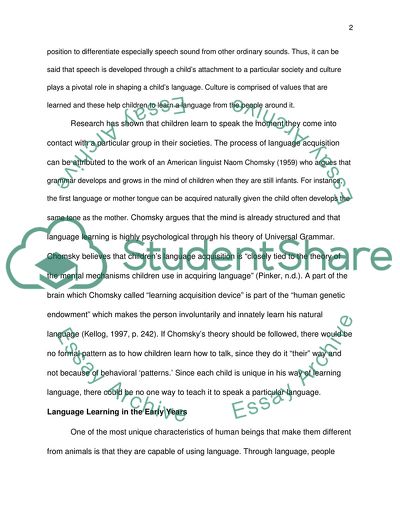Cite this document
(Language Learning in the Early Years Literature review Example | Topics and Well Written Essays - 3500 words - 1, n.d.)
Language Learning in the Early Years Literature review Example | Topics and Well Written Essays - 3500 words - 1. https://studentshare.org/education/1772412-discuss-the-diversity-of-young-childrens-experiences-of-language-and-literacy-at-home-to-what-extent-can-there-be-a-match-between-these-experiences-and-those-they-encounter-when-they-go-to-school
Language Learning in the Early Years Literature review Example | Topics and Well Written Essays - 3500 words - 1. https://studentshare.org/education/1772412-discuss-the-diversity-of-young-childrens-experiences-of-language-and-literacy-at-home-to-what-extent-can-there-be-a-match-between-these-experiences-and-those-they-encounter-when-they-go-to-school
(Language Learning in the Early Years Literature Review Example | Topics and Well Written Essays - 3500 Words - 1)
Language Learning in the Early Years Literature Review Example | Topics and Well Written Essays - 3500 Words - 1. https://studentshare.org/education/1772412-discuss-the-diversity-of-young-childrens-experiences-of-language-and-literacy-at-home-to-what-extent-can-there-be-a-match-between-these-experiences-and-those-they-encounter-when-they-go-to-school.
Language Learning in the Early Years Literature Review Example | Topics and Well Written Essays - 3500 Words - 1. https://studentshare.org/education/1772412-discuss-the-diversity-of-young-childrens-experiences-of-language-and-literacy-at-home-to-what-extent-can-there-be-a-match-between-these-experiences-and-those-they-encounter-when-they-go-to-school.
“Language Learning in the Early Years Literature Review Example | Topics and Well Written Essays - 3500 Words - 1”. https://studentshare.org/education/1772412-discuss-the-diversity-of-young-childrens-experiences-of-language-and-literacy-at-home-to-what-extent-can-there-be-a-match-between-these-experiences-and-those-they-encounter-when-they-go-to-school.


